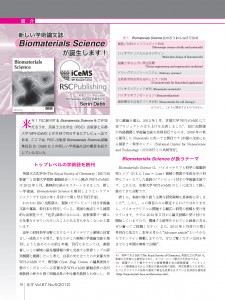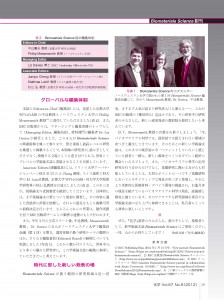 Here’s a medley of biomaterials related reviews published in Soft Matter & Journal of Materials Chemistry. To celebrate the launch of Biomaterials Science we’ve made them all free to download until 31st May. I hope you enjoy reading them.
Here’s a medley of biomaterials related reviews published in Soft Matter & Journal of Materials Chemistry. To celebrate the launch of Biomaterials Science we’ve made them all free to download until 31st May. I hope you enjoy reading them.
Highlight
Biofabrication: programmable assembly of polysaccharide hydrogels in microfluidics as biocompatible scaffolds
Yi Cheng, Xiaolong Luo, Gregory F. Payne and Gary W. Rubloff,
J. Mater. Chem., 2012, 22, 7659-7666
Review Article
Surface modification of magnetic nanoparticles for stem cell labeling
Koon Gee Neoh and En Tang Kang,
Soft Matter, 2012, 8, 2057-2069
Emerging Area
Inhibiting, promoting, and preserving stability of functional protein fibrils
Owen Griffith Jones and Raffaele Mezzenga,
Soft Matter, 2012, 8, 876-895
Review
Shear-thinning hydrogels for biomedical applications
Murat Guvendiren , Hoang D. Lu and Jason A. Burdick,
Soft Matter, 2012, 8, 260-272
Feature Article
Biomimetic composites and stem cells interaction for bone and cartilage tissue regeneration
N. Naveena , J. Venugopal, R. Rajeswari, S. Sundarrajan, R. Sridhar, M. Shayanti, S. Narayanan and S. Ramakrishna,
J. Mater. Chem., 2012, 22, 5239-5253
Feature Article
Biofunctionalization of nanoparticles for cytosensing and cell surface carbohydrate assay
Lin Ding and Huangxian Ju,
J. Mater. Chem., 2011, 21, 18154-18173
Feature Article
Biological modifications of materials surfaces with proteins for regenerative medicine
Binata Joddar and Yoshihiro Ito,
J. Mater. Chem., 2011, 21, 13737-13755
Feature Article
Single-walled carbon nanotubes in biomedical imaging
Zhuang Liu, Kai Yang and Shuit-Tong Lee,
J. Mater. Chem., 2011, 21, 586-598
Feature Article
Emerging functional nanomaterials for therapeutics
Xuejia Xue, Feng Wang and Xiaogang Liu,
J. Mater. Chem., 2011, 21, 13107-13127
Feature Article
Mesoporous silica nanoparticle based nano drug delivery systems: synthesis, controlled drug release and delivery, pharmacokinetics and biocompatibility
Qianjun He and Jianlin Shi,
J. Mater. Chem., 2011, 21, 5845-5855
Review Article
Designing biomimetic scaffolds for bone regeneration: why aim for a copy of mature tissue properties if nature uses a different approach?
Bettina M. Willie, Ansgar Petersen, Katharina Schmidt-Bleek, Amaia Cipitria, Manav Mehta, Patrick Strube, Jasmin Lienau, Britt Wildemann, Peter Fratzl and Georg Duda,
Soft Matter, 2010, 6, 4976-4987
Review Article
Design of biomaterials to enhance stem cell survival when transplanted into the damaged central nervous system
M. J. Cooke, K. Vulic and M. S. Shoichet,
Soft Matter, 2010, 6, 4988-4998
Don’t forget if you want to find out about the first Biomaterials Science articles once they’re published online you can sign up for the Biomaterials Science RSS feed or Table of Contents alert.
To keep up with the latest news you can Like us on Facebook or Follow us on Twitter.


















 The latest issue of the Biomaterials Science newsletter is out. It contains a roundup of all the latest news about the journal.
The latest issue of the Biomaterials Science newsletter is out. It contains a roundup of all the latest news about the journal.

